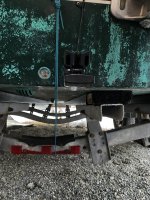C-Wolfe
Member
- Joined
- Sep 16, 2020
- Messages
- 351
- Reaction score
- 0
- Location
- Anchorage
- C Dory Year
- 2008
- C Dory Model
- 255 Tomcat
- Vessel Name
- Valhalla
I will be replacing my original MFD (2006(?) Garmin GPSMAP 545S /transducer ?) with a echomap ultra 106SV and GT54UHD-TM transducer. The current unit was loosing deep quite often, I have not try very hard to figure out a pattern but I would say that it was at most planing speed and deep over 100 ft. (I was also losing deep over 600ft at any speed but that is probably related to transducer power limitation). The transducer is mounted on starboard side of centerline, I do have a scupper on port side of center line and the boat has twin engines (BF50) I don't see having much other option as to where to install the new transducer then current location but will appreciate any info anyone can provide. Hopefully the problem was due to age or wear and the upgrade will solve it but I would like to make sure there is no better location before I start drilling hole in the transom. :teeth






